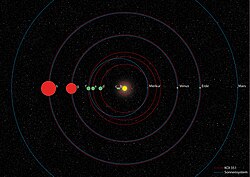Kepler-90 system rightward-PIA22193
https://photojournal.jpl.nasa.gov/catalog/PIA22193
With the discovery of an eighth planet, NASA's Kepler-90 system is the first to tie with our solar system in number of planets. This is an artist's concept compared with our own solar system.
Our solar system now is tied for most number of planets around a single star, with the recent discovery of an eighth planet circling Kepler-90, a Sun-like star 2,545 light years from Earth. The planet was discovered in data from NASA's Kepler Space Telescope. This artist's concept depicts the Kepler-90 system compared with our own solar system.
The newly-discovered Kepler-90i -- a sizzling hot, rocky planet that orbits its star once every 14.4 days -- was found using machine learning from Google. Machine learning is an approach to artificial intelligence in which computers "learn." In this case, computers learned to identify planets by finding in Kepler data instances where the telescope recorded changes in starlight caused by planets beyond our solar system, known as exoplanets.
NASA Ames manages the Kepler and K2 missions for NASA's Science Mission Directorate. JPL managed Kepler mission development. Ball Aerospace & Technologies Corporation operates the flight system with support from the Laboratory for Atmospheric and Space Physics at the University of Colorado in Boulder.
For more information on the Kepler and the K2 mission, visit www.nasa.gov/Kepler.
For more information about exoplanets, visit https://exoplanets.nasa.gov/.Relevante Bilder
Relevante Artikel
Kepler-90Kepler-90 ist ein etwa 2800 Lichtjahre entfernter Hauptreihenstern in der Milchstraße. Er ist möglicherweise ein sonnenähnlicher Stern und etwas größer und leuchtkräftiger als die Sonne. .. weiterlesen



